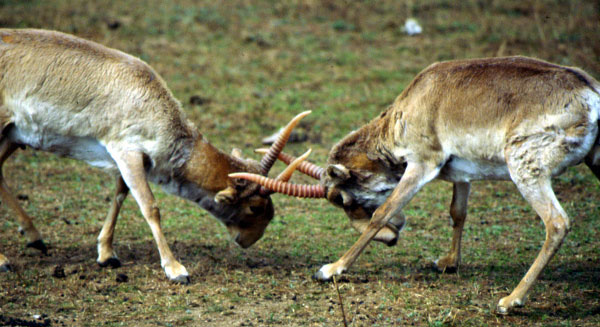Russian airship is suspected of killing antelope
Scientists suspect the launch and return of the Russian spacecraft causes more than ten thousand dead antelopes in Kazakhstan.
>>> Therare and precious African antelope is in danger of extinction
In the last two weeks of May 2010, people discovered more than 12,000 saiga antelopes (Saiga tatarica) died in Kazakhstan. At that time, 12,000 equaled 15% of the total saiga antelope worldwide. Just one year later, the bodies of about 450 saiga antelopes were seen again in the last two weeks of May, Kazakhstan Today reported. Then exactly a year later, the bodies of nearly 1,000 saiga antelopes were found in the past two weeks.
Experts have speculated that blood clots, a type of lung disease caused by bacteria, cause saiga antelope to die massively in 2010 and 2011. Healthy animals rarely infect bacteria causing congestion. coincidence, but the risk of infection of those with weak immune systems is very high.

Saiga antelope
This time, Kazakhstan's Ministry of Agriculture concluded that antelope died of haemorrhage, but they did not give any evidence to prove it.
Some ecologists in Kazakhstan and Russia disagree with the conclusion of Kazakhstan Ministry of Agriculture. They claimed that the antelope died massively due to the landing of a Soyuz spacecraft after it left the International Space Station (ISS) in April. According to them, people discovered more than 120 saiga antelope near Sorsha village. The Soyuz ship fell in April. Some other scientists thought the Baikonur space airport in central Kazakhstan was related to the mass deaths of antelopes, Scientific America reported.
'It is possible that the chemicals emitted by the rocket have spread in a large space around the cosmopolitan airport and they have killed the antelope' , ecologist Musagali Duambekov, leader of the movement. For a Green Planet, speak to Radio Free Europe.
In addition, according to Duambekov, people's habit of using excessive fertilizers may also be factors that cause the animal's immune system to decline.
Many people believe that the tragedy of antelope happens because of other natural causes. Eleanor Milner-Gulland, head of the Saiga Antelope Conservation Alliance, said that the antelope probably ate too many wet plants, which contained many harmful bacteria, during the breeding season. Most dead antelopes are females who have just given birth. Therefore, after eating leaves containing bacteria, their immune systems weaken, making them sick and dead. Their children also died due to lack of milk.
The number of saiga antelopes all over the planet has reached several million. But after the collapse of the Soviet Union, hunting was rampant, causing their number to drop dramatically. Today, according to scientific calculations, the number of wildebeest in the wild is about 85,000. They are divided into separate populations in Russia, Kazakhstan, Uzbekistan and Mongolia. The main threat to saiga antelopes is the need to buy their horns in Asia. Asians believe that saiga antelope horns can cure headaches, fever, sore throats and many other diseases.
- Project Atlant: Unique airship hybrid
- Tiny antelope
- Close up of hungry harpooning to rejuvenate young antelope
- Russian airship to space station
- The mystery caused 85,000 Saiga antelope deaths
- Isolation of two Russian tourists suspected of MERS infection in Da Lat
- The old antelope wisely escaped death before the hyenas
- Find the culprit causing 200,000 Saiga antelope to die in a month
- Marvelous paradise on a mountain range
- The giant antelope in Mongolia
- The extremely rare Bongo antelope was born in England
- The Russian spacecraft suddenly flew up
 Animal 'suffering' after hibernation
Animal 'suffering' after hibernation Why do goats climb well?
Why do goats climb well? Scientists were surprised to see chimpanzees eating turtles
Scientists were surprised to see chimpanzees eating turtles Giant catfish died deadly due to drought in Thailand
Giant catfish died deadly due to drought in Thailand